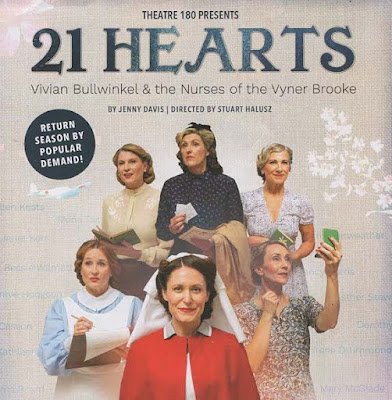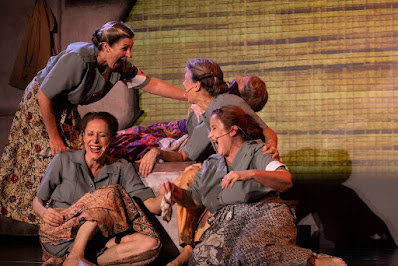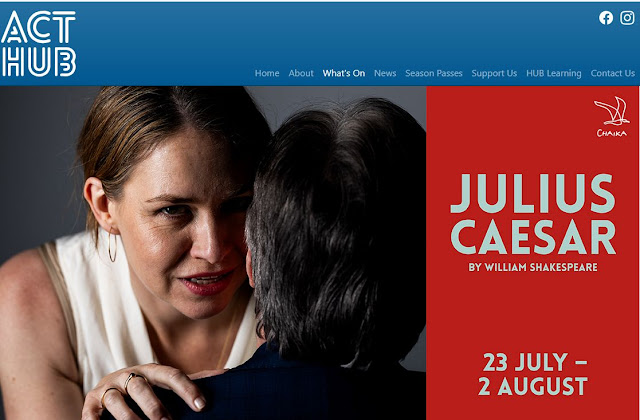Stages of Empathy presented by Rebus Theatre. Opening night at Ralph Wilson Theatre, Gorman Arts Centre, Canberra. July 31. 2025.
Reviewed by Frank McKone
Artistic Director and Joker: Sammy Moynihan – He/Him
Project Manager: Harry Bhangu – He/Him
Wellbeing Officer: Verity Kimpton – She/Her
Accessibility Manager: Yenn Purkis – They/Them
Cast – Opening Night
Terry: Krystle Vicencio – She/Her
Jordan: Mark Polhuis – He/Him
Lee: Emily Smith
Alex / Sam: Zander Hanmer-Woods – He/Him
Cast – August 1
Jay Taylor – She/Her plays Lee
Josh Rose – He/Him plays Terry and Sam
Zander Hanmer-Woods plays Jordan
Sammy Moynihan tells me of his experience in Brazil where he was inspired by Augusto Boal’s approach to making political change. AI is useful for summarising about Theatre of Oppression:
AI Overview
Founder of the Theater of the Oppressed, playwright Augusto Boal, a Brazilian theatre practitioner, developed the Theatre of the Oppressed (TO) as a form of popular education using theatre to address social and political issues. Forum theatre, one of the techniques within TO, specifically focuses on empowering audiences to actively participate in the performance, influencing and changing the narrative to explore solutions to oppression. Boal's work, particularly his concept of the "spect-actor," encourages audience members to become active agents of change, stepping into the performance to explore alternative actions and resolutions to the presented conflict.
The oppressed people Moynihan is concerned about are those with disabilities who are excluded unfairly from activities and decision-making positions in workplaces, often because of biased views about disabled people.
Rebus Theatre has always been about involving disabled members of the company performing theatre in the standard way – for an audience to watch and become aware of the actors’ capacities, and so for the abled to learn to recognise, perhaps intuitively, their biases against the disabled.
In Stages of Empathy, Moynihan and his team take us to the next stage in a cleverly devised form of Forum Theatre. As a one-time drama teacher, I see this work as a form of educational drama – as enjoyable and as much a learning experience that I hope my classes were.
The politics is at the personal relationship level rather than at Boal’s governmental revolution level. On a day-to-day level in the office, especially here in a public service town, learning how to make fair and more effective approaches to decisions for and by other people – disabled or not – is what Stages of Empathy is all about.
The Rebus actors play a shortish couple of office scenes in an organisation supporting artists – in this case visual artists, drawing, painting or sculpting. The CEO is explaining to a new recruit in the management that for this year’s upcoming exhibition, Jordan’s artwork should be included because it is excellent, but Jordan should not be allowed to be present to talk to the public, especially the media, because last year he was an embarrassment, going into some kind of explosive panic attack which showed the organisation in a bad light.
The CEO Terry is insistent; Lee, inexperienced in her new management role, wants to offer an exciting sound-and-light show, and needs to please her boss; Alex is one of the artists, already very successful, who tries to push Jordan along. But Jordan has a disability because of which loud sounds and bright lights will overwhelm him – the cause of the panic attack last year.
After the performances, Sammy takes on what I saw as the teacher role, inviting members of the audience to stop the action as the actors begin to repeat the performance, and to come on stage to take over one of the characters and show how that character could have made a better decision towards not just being fair and supportive to Jordan at this point in planning the exhibition, but to help make the relationships warmer, less bureaucratic, leading to a successful exhibition for Jordan and also for the organisation as a whole.
Usually, Rebus is working for this kind of relationship development in a workshop training situation. It needs an intimate space for a theatre presentation for the general public.
The theatre at Gorman House, suitably named after one-time Principal of Canberra High School, Ralph Wilson – famous in his day for his support of the arts and particularly drama – plays the role perfectly. As did Rebus’ actors.
And, as it should, the show on opening night became an evening of lively action and thoughtful discussion by everyone no longer just in the “audience”. A very successful Rebus project indeed towards unbiassing people towards disability.
 |
| Rebus Theatre - Stages of Empathy The actors ready for action |
©Frank McKone, Canberra


























